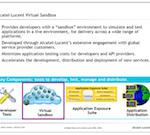 A couple of weeks ago, in this post, I mentioned that Alcatel-Lucent had assembled some very impressive resources to enable carriers to lure third-party developers. Yesterday, at the Mobile World Congress (MWC2010), the company formally launched a much better organized, “cloud-based developer suite” which includes an aggregation of API’s (application programming interfaces) and promotes what it calls “a game-changing” business model to lure more developers to take advantage of features and services embedded in the public network.
A couple of weeks ago, in this post, I mentioned that Alcatel-Lucent had assembled some very impressive resources to enable carriers to lure third-party developers. Yesterday, at the Mobile World Congress (MWC2010), the company formally launched a much better organized, “cloud-based developer suite” which includes an aggregation of API’s (application programming interfaces) and promotes what it calls “a game-changing” business model to lure more developers to take advantage of features and services embedded in the public network.
The core of the platform is ALU’s “Application Exposure Suite”, which gives developers access to API’s that suppot such things as location services, along with fundamental capabilities such as provisioning, billing, system management and reporting. Newly announced at MWC is a Virtual Sandbox, which has a “try-before-you-buy” feel to it and enables developers to build applications, test them and simulate traffic across a wide range of devices and environments.
In this press release, ALU asserts that it is the first into the market with such a comprehensive approach. It sees it as an important mechanism to support a global community of 14+ million mobile and telecom application developers. There are also hooks into resources that support distribution and billing for a range of new applications. The ability to developer, test and implement new applications quickly is a pre-requisite to the age of Recombinant Communications. Access to well-defined API’s is crucial to the introduction of new communications-enabled business processes (CEBPs) that extend enterprise resources to mobile devices, improve a caller’s experience, or make the lives of road warriors (both sales people and service techs) more efficient. More importantly, it better fits the “smart pipe” strategies that carriers are adopting to stave off the slow decline into pure commoditization.
Categories: Articles

 NiCE Interactions 2025: Agentic AI, Better Data, and a Whole Lot of Partnership
NiCE Interactions 2025: Agentic AI, Better Data, and a Whole Lot of Partnership  Getting It Right: What AI Agents Actually Mean for Customer Support (Webinar)
Getting It Right: What AI Agents Actually Mean for Customer Support (Webinar)  Beyond the Basics: How AI Is Transforming B2B Sales at TP
Beyond the Basics: How AI Is Transforming B2B Sales at TP  Five9 Launches Agentic CX: Toward AI Agents That Reason and Act
Five9 Launches Agentic CX: Toward AI Agents That Reason and Act